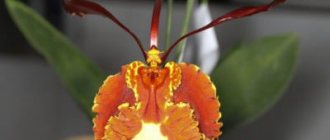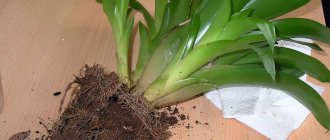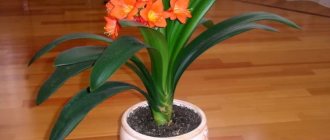Fastidious handsome man
Croton, or codiaum as it is often called, belongs to the Euphorbiaceae family, which includes many tropical forest dwellers and ornamental houseplants.
You may be interested in: Tea rose: home care, planting, watering and propagation
As you understand, growing conditions in the tropics and at home are very different. Therefore, in the wild, crotons reach three meters in height. At home, with proper care, the plant can reach 1.5 meters. Having overcome some difficulties in care, you can get a beautiful flower that delights with its variegated foliage. The effort you put into the grooming process is worth the results you ultimately get.
Description of the flower
Croton is sometimes called codiaum or "Joseph's cloak." Translated from Greek, the name of the plant means “head”. Why the culture received such a name, experts do not know for sure. There is an assumption that the plant was named after a city in southern Italy.
The islands of Northern Australia and the Pacific Ocean, as well as Southeast Asia and India are considered the homeland of wild forms of croton. The genus has many species. But indoor culture is represented only by variegated croton and its hybrids. The croton flower (photos are given in the article) is considered one of the most beautiful decorative indoor crops. The plant is used as interior decoration. In some countries, croton is considered the guardian of the hearth, which protects the apartment from negative energy.
At home, the plant usually does not exceed 1-1.5 m in height, even with the best care. The description of a croton flower, of course, cannot convey all its beauty. The decorative nature of the plant is its main advantage. Crotons are very often used to decorate halls, lobbies, offices and other premises. Their beautiful leaves of various shapes and bright colors invariably attract people's attention. Externally, codiaums resemble a small tree. The formation of the crown occurs quite slowly, so you should not hope for a quick result. In order to get a beautiful bush, the plant is periodically pruned.
You may be interested in: Violet Green Rose: photo and description
Codiaum is a flowering plant. But the culture rarely blooms. At the same time, the plant produces an arrow with small, inconspicuous flowers, painted in a light yellow tint. It is worth saying that flowering does not add any special beauty to croton. But the plant spends a lot of energy and nutrients. Therefore, many gardeners prefer to initially remove the arrow so that the crop does not lose its supply of nutrients.
Types of culture
Several varieties of crotons are used for growing at home. Flowers differ in the shape and size of the leaves, as well as their colors. The most popular species is the Variegated Croton. The plant has the shape of a bush, the height of which reaches three meters. The branches of the crop bear green-brown leaves. There are several varieties, the main difference of which is the shape of the foliage:
- Excellent variety. The plant has characteristic oak leaves, yellow-green above and red-burgundy below.
- Disraeli variety. The plants have lobed leaves, brick-brown underneath and green-yellow on top with characteristic veins and specks.
- Variety "Black Prince". This plant has a very exotic appearance. The black surface of the foliage has red and orange spots and veins.
- Petra variety. Plants of this species may have lobed, oval and pointed leaves of a dark green color with yellow veins and specks.
- Variety "Mrs. Iceton". The small trees have brightly colored foliage, which can be yellow-pink, dark burgundy with pink speckles, or golden with black dots.
- Flat-leaved croton has oval wavy leaves that reach a length of 30 cm and a width of 10 cm.
- Lobed appearance. Its distinctive feature is its three-lobed leaves, which can be monochromatic or variegated in color. They reach 22 cm in length.
- The adventitious croton has characteristic green and variegated leaves, which consist of several plates.
- Decorated codiaum is actively used by breeders to obtain new hybrids.
You may be interested in: Violet Green Rose: photo and description
Croton varigatum is no less popular among gardeners. The plant has the shape of a bush with a bare stem. The leaves of the flower are painted in green-brown tones. Varigatum is represented by several types:
Description of types and varieties of croton
There are about 17 species of croton, and many of them are cultivated. They have different colors and textures of foliage - green, orange, reddish and look very original in the design of the room.
Croton varigatum (variegated)
This species is distinguished by a variety of foliage colors: there are varieties with burgundy, autumn tones, as well as with bright green variegated leaves, which will bring special dynamics to the home garden.
They look great on their own or in combination with other indoor plants, contrasting against their background. They grow at least half a meter in height, and under favorable conditions they can reach 80-100 cm.
Croton varigatum (variegated)
Croton dragon
The species received its name thanks to the legend of the Indian tribes of South America: it is believed that its reddish resin gives strength to warriors and provides the protection of the dragon. That's why it's called dragon's blood.
The leaves are bright and dark green with variegated stripes of reddish and yellow. They contrast well against each other and enliven the space.
Croton dragon
Croton spinyfruit
This species is similar in appearance to a dragon. It also has red and green leaves of various colors. They are somewhat smaller in size. The resin from this tree, which is extracted from natural crotons, is still used as a raw material for the production of varnishes.
Croton spinyfruit
Croton angustifolia
A very original codiaum with peculiar narrow leaves of green and orange-crimson shades. In favorable conditions, it can grow more than a meter, so it is often used as a floor decoration.
The leaves are variegated, with yellow splashes, and look good in combination with bright indoor flowers.
Croton angustifolia
Croton Petra
Croton Petra has leaves that are classic in shape. The colors are pale yellow, various shades of green and dark pink. This is a particularly popular species among gardeners because it is densely covered with leaves that grow from a straight, powerful stem and give the plant the appearance of a beautiful tree.
Croton Petra
Croton Mrs. Eyeston
This is perhaps the most original variety. It simultaneously contains dark, light green, as well as yellow, scarlet and red foliage. It looks like a real bouquet, so it can be given to a lady.
Requires special care conditions - loves constant moistening of its numerous leaves; otherwise they quickly begin to fall off.
Croton Mrs. Eyeston
Croton Excellent
This type of codiaum has a very peculiar, characteristic foliage shape: a rounded leaf with a pronounced rounded end. Overall it resembles the head and shoulders of a person. Color ranges from pale green to rich tones (there are also yellow and pink).
Croton ExcellentCroton Zanzibar
This species is a true embodiment of the tropics: narrow foliage with lush colors; red, burgundy, yellow and green leaves grow on the same tree. This type of codiaum brings the design to life well, so it is better to place it in the most visible place.
Croton Zanzibar
Croton mix
A species with typical foliage color and shape, well decorated on trees. It has powerful woody stems. The foliage develops very rapidly, so it is better to immediately pluck off excess shoots.
Croton mix
Purchasing a plant
What kind of care should be provided to Croton at home (photos of the flower are given in the article)? Much depends on the quality of the plant you purchased in the store. Therefore, I would like to say a few words about how to choose the right plant. Buy only those specimens that look healthy. Plants should have hard, elastic leaves with bright colors. There should be no traces of pests on their surface.
Specimens with limp foliage should not be purchased, as they will certainly fall off during adaptation in your home. And in the worst case, the plant may even die. It is worth giving preference to young bushes, since they take root easier and endure the adaptation period more easily. It is not necessary to purchase a ready-made plant in a store; it is enough to break off a cutting from a croton you like from friends or neighbors.
Lighting and temperature
Maintaining the required temperature and proper lighting is the basis of home care. The indoor croton flower differs from other crops in the stunningly bright color of its leaves, which attracts the attention of gardeners to it. In order for the bushes to delight with their variegated color, they must be placed in a well-lit place. It must be remembered that with a lack of light, the plant loses its unique decorative effect. But at the same time, in summer, crotons need to be shaded from direct rays. The leaves of the crop only seem tough. However, from the sun they quickly develop burns that look like spots. In winter, the plant can be placed on a south window. If you organize your care correctly, the croton flower will certainly delight you with its beauty.
It must be remembered that the homeland of codiaum is the tropics, so the culture is heat-loving. Correct temperature conditions are an important component of home care. The croton flower is demanding on the air temperature of the room in which it is located. The optimal temperature for the crop is +20…+22 degrees. Please note that the temperature should not fall below +16 degrees. In summer, bushes can be placed on the balcony or taken out into the garden, providing protection from the wind and scorching sun rays.
Where to put a pot of croton?
When placing this flower in the house, it is worth considering several factors. Croton feels great in a well-lit room, but does not tolerate direct sunlight, which in spring and summer can leave burns on its beautiful leaves.
But in winter it is better to place the flower on a south window, and direct rays will only benefit it. By the way, the color of croton leaves depends on the lighting. A lack of light can manifest itself in the fact that the leaves will lose their decorative effect and will have an even green color.
In addition, you should not place the flower near heating appliances. He also does not like drafts. If you see that the leaves of the croton have become lethargic, changed their color and began to fall off, then this means that the place for the flower is chosen incorrectly.
Humidity
It must be remembered that the tropical inhabitant loves high air humidity. Therefore, spraying bushes should become a regular home care procedure. The croton flower should be regularly bathed and sprayed with a spray bottle in the spring and summer.
If the plant is kept in a cool room in winter, water procedures can be practically eliminated. But remember that heating dries out the air quite a lot. If you don’t want to bother yourself with winter spraying, move the bushes away from the radiators. Otherwise, you will have to humidify the air twice a day. In addition, you can increase the humidity in a simple way. Near the pot you need to place a vessel with water or a tray with wet moss or expanded clay. There is another way to maintain the necessary humidity for a croton flower. Care at home can be greatly simplified if you use a humidifier, which is best placed near the bush.
Another important point in care is regularly wiping the leaves with a damp sponge. The procedure must be carried out at least once a week.
The soil
For planting, you can buy a ready-made soil mixture for decorative foliage plants or make it yourself from equal parts:
Fertilizing of codiaum is carried out during the period of active growth 2 times a week. To do this, you can use fertilizers for decorative foliage plants.
The soil for codiaum should be fertile, but easily permeable to water. To do this, use coarse sand as a leavening agent. You can replace it with other components: perlite or vermiculite.
The plant grows best in slightly acidic soils. Peat is needed to acidify the substrate. When using store-bought soil mixtures, you need to make sure that peat is included in their composition.
Watering
Very often, amateur flower growers have many questions regarding the correct care at home. The indoor croton flower cannot be called an unpretentious crop. He is very sensitive, so his care must be especially careful. It is important to properly organize watering of the plant. It is necessary to moisten the bushes in such a way that the soil is always slightly moist. But it is important not to allow water to stagnate in the roots. Watering is one of the most important components of care. The croton flower does not like dryness, but also does not tolerate excess moisture, which leads to rotting of the root system. At the same time, excessive dryness causes foliage to fall and dry out.
You may be interested in: Indoor Hippeastrum flower: care at home
Therefore, it is recommended to use drainage when planting. The croton flower (see photo in the article) must be watered regularly and abundantly, but not allow moisture to stagnate.
In winter and autumn, watering should be reduced if the room is cool. Experienced gardeners recommend using only warm, settled water. This condition applies not only to watering, but also to spraying. It is better to take filtered water. In summer, the plant needs a shower.
Croton formation
Question: Does it need to be pinched for branching, or does it bush on its own? It’s just that it’s still small for me - 12 leaves.
Kroky: If the croton is large-leaved, there is no need to pinch or take cuttings. These produce lateral shoots very poorly (if at all). I had a bad experience with Gold King Croton. My cat decided to “pinch” it. He bit out the growth point. No side leaves appeared, but a new growth point appeared on the top leaf. This happened twice. After the third “pinching”, the croton gave up and began to die. None of my manipulations helped.
Helen: yes, you can, I pinched and trimmed mine, after which they branch, but not profusely. And without pinching or pruning it produces 1 or 2 side shoots in a couple of years of cultivation.
Fertilizer use
All the beauty of the variegated color of the plant can be appreciated from the photo of the croton flower. How to care for the crop to get the same beautiful bushes as in the store? It is necessary to fertilize the plant regularly. From April to November it is necessary to do two feedings per month. But in winter, one fertilizer per month is enough.
For fertilizing, you should use complex mineral fertilizers created for decorative deciduous crops. Fertilize the plants after abundant watering so as not to burn the roots.
How to trim croton to keep it fluffy
The beauty grows in the form of a bush or tree; over time, the old leaves on its shoots dry out and fall off, the shoots stretch out and lose their decorative effect. And the flower itself no longer grows so actively and thickly over the years. Pruning is done, first of all, to stimulate growth, acquire new forms of the bush, renew shoots and cuttings.
To make codiaum branch, you need to pinch all the shoots
The formation of a full-fledged crown of this tree must be done by stage-by-stage pruning:
- at 1.5 years the plant is pinched to awaken the lateral buds and create new shoots;
- at 2 years, partial pruning is done, regulating the growth of new shoots - adjusting the growth of shoots will help to form a beautiful and desired crown shape;
- at the age of 5, full pruning is done: here the emphasis is no longer on crown formation, but more on stimulating growth, since at this age the flower begins to slow down its growth processes.
Croton pruning should be done with a sharp, machined tool in one motion for each cut. Treat the cut areas with charcoal several times after the procedure. After pruning, give the plant rest, place it in partial shade, and reduce watering.
Important! After pruning, the plant should not be sprayed - the cut areas may rot. Proper care of any plant guarantees a healthy and beautiful appearance.
Croton will respond with gratitude with a palette of bright colors of its amazing leaves. It is important to approach plant care with love in order to create warmth and comfort in the home.
Proper care of any plant guarantees a healthy and beautiful appearance. Croton will respond with gratitude with a palette of bright colors of its amazing leaves
It is important to approach plant care with love in order to create warmth and comfort in the home.
vote
Article Rating
Transfer rules
It's no secret that almost all indoor flowers need regular replanting. Croton is very capricious when caring for it at home. But at the same time, it needs an annual transplant of young bushes. Transshipment of adult plants can be done much less frequently - approximately once every three years. Transplantation should be carried out in the spring before the growing season begins.
For croton it is necessary to use soil that most closely matches the soil in which it grows in its natural environment. Many gardeners recommend purchasing a ready-made substrate. But you can prepare the mixture yourself. To do this, you need to mix humus, sifted sand, turf soil and peat in equal proportions. By the way, you can add charcoal to the mixture to avoid rotting of the root system. The prepared mixture must be calcined in the oven or spilled with a solution of potassium permanganate so that no insect larvae remain in it.
The convenience of the finished substrate is that it can be used without pre-treatment.
Mistake #1. Wrong location
A pot of codiaum (croton) should not be placed near radiators, although this plant loves warmth. It is advisable that the air temperature in winter does not fall below plus 19°C during the day, plus 18°C at night.
Dry air is destructive. First, the tips of the leaves dry out, then they fall off.
Not everyone knows that this light-loving plant not only gets burned when direct sunlight hits its leaves, but can shed them. Low lighting causes variegated forms to lose color. For such conditions, codiaums (crotons) with a predominance of green leaf color are more suitable.
Croton (codiaum) does not like sudden changes in air temperature. Suffers from icy drafts.
Plants with large leaves grow faster than crotons with narrow and small leaves. This should be taken into account when choosing a location and landing capacity.
Young plants are replanted annually in spring (March-April), then every two years. You can replace replanting by transferring it to a larger pot. Old crotons are rarely replanted. Instead, replace some of the soil in the pot or tub. The soil mixture is prepared from leaf and turf soil, adding sand, pieces of charcoal, crushed sphagnum moss and neutral peat. There must be drainage at the bottom of the container.
Choosing a pot
Before planting a croton flower, you need to choose the right pot. For young bushes, it is worth taking a medium-sized pot that is not deep. There should not be a lot of extra space in the pot, otherwise the roots may rot. It is necessary to replant the plant if you notice that roots are visible from the drainage hole. The new flowerpot should be slightly wider than the previous one. The diameter must be increased by no more than 5 cm.
Young plants brought from the store do not need urgent replanting. The supply of nutrients in the substrate will last them for a long time. At the initial stage, it is important to provide proper care for the flower. Croton (photo shown in the article) must adapt to your apartment and get used to new conditions. Moving it from the store to your home is stressful for the plant. Therefore, replanting at this time can lead to the death of the bush.
How to plant croton at home
If you decide to grow your own croton, you need to know a few nuances for the proper development of the plant.
Did you know? Croton is able to optimize the workplace environment for successful negotiations and protects the owner from the negativity of strangers.
Where to place croton: choosing a location and lighting
Croton needs to be provided with a sunny place.
The color of its leaves depends on the amount of light. The plant is not afraid of direct sunlight, so you can place the flower directly on the windowsill and not create diffused light. The window should face east or west. You also need to monitor the plant after purchase, as the croton must get used to the new place. If he likes the place, the crown will acquire a unique color, and if, on the contrary, there is not enough light for him, the leaves will be ordinary, that is, green. In winter it is better to expose the plant to direct sunlight, but in spring it should be avoided.
Requirements for temperature and humidity
The optimal temperature for croton in summer should be 30 °C.
In winter, it is better to stick to 13 °C, since he does not like temperature drops, especially for a long time. When the temperature drops sharply below 10 °C, the leaves will begin to fall, so it is better to place it closer to the radiator. As for humidity, croton loves dry room air, namely 80%. In summer, air humidity should rise, so the plant should be frequently sprayed with distilled water. In winter, when the temperature drops, it is better not to touch the flower and just water it.
What should the soil be like for planting?
Croton loves fertile and slightly acidic soil mixtures.
You can make them yourself. Garden mixture, peat and sand are taken and mixed in a ratio of 2:1:1. You can also add leaf soil, and for adult plants this component is increased. Before planting, the soil should be watered with a weak solution of potassium permanganate. After the mixture has dried, you can begin replanting.
How to choose a pot for croton
The pot for croton should be ordinary and the size of the root system of the plant
This is important because if you choose a pot for the plant that is too large, you may flood it. A regular plastic pot will do; it will be more convenient for you to transplant the croton into another pot.
The process of replanting a purchased plant
Expanded clay should be placed at the bottom of the pot.
It should fill the pot ¼ full. Then you need to carefully remove the earthen lump from the pot. If you see that the surface of the clod is covered with roots, you need to carefully transfer the plant into a new, slightly larger pot. If the roots are covered with soil and there are not very many of them, then the plant needs to be replanted in a pot that is suitable in size for the croton. You can also add some root feeders, for example, “August”. These fertilizers are long lasting. When adding such fertilizers, the root system will crawl out through the holes in the bottom of the pot, so it is better not to add water to the pan.
Transfer
Many novice gardeners are wondering how to plant croton. The flower needs good drainage. Therefore, at the bottom of the pot it is necessary to put a layer of expanded clay, the thickness of which should be at least three centimeters. Before planting, the plant must be well shed in order to carefully remove the roots from the old pot without damaging them. If the earthen lump does not disintegrate, the root system will remain intact.
Soil is poured into the bottom of the container with drainage. Next, place the flower in a flowerpot and cover the roots with soil. The soil is pressed down with your hands. The planted bush is watered abundantly with settled water. In the future, it is very important to provide proper care for the flower. Croton (see photo in the article) after transplantation must be placed in a slightly shaded place. The plant must be regularly watered and its leaves sprayed.
Young crotons are replanted annually. As soon as the plant is transplanted into a container with a diameter of 25 cm, it is no longer transferred. The top of the soil can be renewed annually. This is quite enough for the plant.
Croton soil
Question: I bought a croton, do I need to replant it or is it enough to transship it, and in what land?
Kroky: Take universal soil from the store, add vermiculite to it (a fifth), and a slightly larger pot (2-3 cm in diameter), store-bought ones are usually of such a size that it is not clear how the flower was stuffed there. The method of transplantation is a matter of taste and the condition of the roots. If the roots are normal, shake off the earthen ball a little and plant the croton. After transplantation, spray with epin - it is an immune system stimulant.
Ann: The soil for croton is the most common - this plant is not picky about the soil, as long as it does not turn sour (covered with a salt coating). You can take garden soil, but add more vermiculite to it, about 1/4 of the total mass. If you buy soil for croton in a store, choose the one for palm trees, ficus, and monstera. Don't forget about drainage at the bottom of the pot!
Question: What kind of pots do crotons like: shallow or deep? My croton grows so slowly, although the color is juicy, and the leaves seem to be on different levels - one floor has large leaves, the second - small ones, and so they alternate. I think maybe the pot has become too small?
irina-bahus: He doesn’t need a small pot, a regular one will do. Only proportionate to the roots - in a large pot there is a very high probability of flooding. My Gold Star croton grows slowly, too, but Exellent grows quickly. Maybe this is a feature of the variety.
Reproduction
How to grow croton? The flower can be propagated in several ways: seeds and cuttings. The last method is very simple and convenient. To get a young plant, just cut off the top of the bush and root it. If you want to get several cuttings, you need to divide the shoot into several parts. Please note that each piece of stem must have at least one healthy leaf and one internode. Only in this case can the cuttings be rooted and a new flower obtained. Croton propagation is not difficult. The resulting pieces of stem, when cut, secrete milky juice, which is a toxic substance. White juice must be washed off with water. Next, the cuttings are dried for several hours. Leaves are removed from their lower part. The upper leaves are cut in half parallel to the veins.
Dried cuttings can be placed in a vessel with water. The liquid in the container should not be cold (+23…+30 degrees). In cooler water, the plant will not only not produce roots, but will also rot. How to propagate a flower? Croton, the photo of which is strikingly beautiful, can be planted in a pot only after roots up to 2 cm long have grown. In the future, it is necessary to regularly spray the soil and the plant itself. When the elasticity of the foliage is restored, the croton will begin to grow.
Propagation by seeds
The plant can also be propagated by seeds. It is important to remember that freshly harvested material must be used for sowing. Croton seeds lose their viability very quickly. Experienced gardeners recommend propagating the plant by cuttings. Firstly, this method is much simpler, and secondly, it allows you to preserve all varietal characteristics. Unfortunately, the same results cannot be achieved with seed propagation. The process takes a lot of time and does not give the desired result.
If you still decide to use the seeds, they must first be heated in water at a temperature of 60 degrees for 30 minutes. Afterwards they must be left to swell in liquid for a day.
Prepared seeds are sown in containers with soil to a depth of no more than one centimeter. The boxes with crops are covered with glass on top and placed in a warm place with a temperature of at least 22 degrees. Before seedlings emerge, watering must be done through a tray. Next, the glass is removed and the pots are taken to a more illuminated place. As soon as the plants have their third leaf, they can be transplanted into separate containers to produce young domestic croton flowers. How to care for seedlings in the future? Caring for seedlings is exactly the same as caring for adult plants.
Seedlings (dividing the bush)
Sometimes the plant becomes too crowded in the pot. In this case, it is necessary to propagate the croton (plant).
The process is also recommended to coincide with the beginning of spring.
Pots with drainage and substrate (soil for young and adults) are pre-prepared. The day before transplanting, the plant is watered abundantly.
Seating is carried out as follows. The codiemu bush is removed and divided into several parts : the main plant and root children . A large bush is planted in a large pot with soil for an adult plant.
Small shoots are placed in small pots with soil for young flowers, covered with plastic wrap and placed in a warm place.
Air layering
You've probably noticed that crotons often have bare trunks. This phenomenon affects the decorativeness of the bush. But don't be upset. From the plant you can get air layering for a young plant. To do this, in June, at a distance of approximately 10-15 centimeters from the top, a circular incision up to 0.8 cm wide is made on the stem. The cut site is certainly treated with a stimulator so that roots form faster. You can also use sphagnum moss, which is wrapped around the plant. The top cut is covered with film and tied with a rope. The oilcloth should not be attached too tightly on top so that the moss can be regularly moistened. The first roots will appear in about a month. But you can cut the cuttings only after the roots have grown to five centimeters. The layering usually retains many leaves. To maintain their vital functions, you will need a good root system.
The cut cuttings are planted in a pot with prepared soil. The seedlings are placed in a shaded place for two weeks. During this period, the plant must be sprayed frequently. It is still very weak, so it cannot receive the required amount of water through the roots.
Layers can be obtained in another way. The lignified shoot is pressed to the ground and sprinkled with soil in this state. To speed up the development of the root system, you can remove the bark from the bottom of the branch. After young leaves emerge from the ground, the new plant can be separated from the mother one.
Diseases and pests: treatment, prevention
| Expressed symptoms | Croton diseases or pests | Control measures |
| The foliage and stem are covered with dense plaques. | Shchitovka | Adults are removed mechanically, having previously lubricated all vegetative parts with foamed laundry soap. Among chemical preparations, it is recommended to use Actellik. |
| A cobweb is visible between the leaves, the plates turn yellow and fall off. | Spider mite | Rinse the plant in the shower, when dry, treat with Fitoverm or Tanrek. Ticks appear in dry, hot air and low humidity. Therefore, it is recommended to spray the bushes frequently. |
| The plates have drooped, withered, and are gradually dying off. | Root rot | The bush can be saved only at the initial stage of the disease. You need to remove the plant, shake off the old soil, trim the roots to a healthy part, dry it and replant it in new soil. Do not water after transplanting! Croton diseases in the form of rot often cause plant death. |
Trimming
In any magazine you can see beautiful photos of a croton flower. How to care for a plant to get the same beautiful tree? The crop requires pruning. By the way, many gardeners neglect it, although pruning is a mandatory part of care. Codium/croton (photo of the flower is given in the article) can have a very beautiful shape if it is formed regularly. Housewives refuse to form a crown due to the poisonous sap of the plant. But this is fundamentally wrong. The fact is that pruning has several functions:
You may be interested in: Watering cyclamen at home: rules for caring for an indoor flower
Don’t be scared by the plant’s poisonous sap, which won’t interfere with pruning at all. After all, in the end you want to get a beautiful indoor flower. How to care for Croton? When pruning the plant, you must wear gloves that will protect your skin. The juice helps the cuttings to tighten quickly, so the cuttings take root well.
The pruning procedure must be carried out regularly. After reaching the required height, all stems should be pinned or trimmed. This will activate the growth of dense lateral shoots.
It is worth saying that care also depends on the age of the plant. Indoor croton flowers are pinched if we are talking about a young bush. On adult specimens, the branches are cut off. After each such procedure, the plant must be treated with stimulants and placed in a greenhouse.
Please note that when pruning, it is necessary to remove flower buds and inflorescences, if any. Modest flowers do not decorate the bushes at all, but they greatly deplete them, which affects their decorativeness. Pruning plants of different varieties has its own characteristics. As you know, Croton "Petra" does not branch very well. If you want to achieve the splendor of the bush, it is worth planting several bushes in one flowerpot. You can create a wonderful mix. In this case, it is necessary to form each plant separately.
Pruning of the crop should be done in early spring. It is better to do this before the onset of the active growing season. The first pinching can be done when the plant reaches 15 cm in height. In this case, the upper growth points are cut off. In the future, all shoots are cut when their length reaches 20 cm. This cutting scheme allows you to awaken the lateral buds in order to force the bush to actively branch.
Forming a beautiful bush is not only about proper pruning. The plant must be regularly rotated relative to the light source. This will avoid one-sided crown. For adult crotons, the cutting area must be treated with crushed charcoal. By the way, cut cuttings can be used to produce new plants.
Croton care at home
A plant such as croton is unpretentious, but you need to know how to properly care for it so that the flower develops quickly and pleases the eye with its color.
How to water a plant
Croton can be watered, sprayed and even washed, but this must be done at least once a week.
In spring and autumn, it is necessary to water the plant every day or every other day.
Important! In between waterings, make sure the soil dries out a little.
Before you start watering croton, you need to warm up the water a little, since the plant does not like cold water. You only need to water with warm boiled water. You can also simply spray the plant. In winter, the flower will need only one watering every 2-3 days.
Features of feeding croton
Croton should be fertilized with mineral and organic fertilizers throughout the year.
In spring and autumn, the plant needs to be fed once a week, in winter - once a month. It is necessary to fertilize with purchased products, but you can also use folk recipes, such as coffee grounds, tea leaves and banana peels. The grounds and tea leaves are steamed and added once every 2 weeks. The banana peel should be cut into pieces and placed in the pot. Then it is covered with soil and watered. Banana peels degrade over time.
If all requirements are met, croton will show flowers in a few months, but the main thing is proper care. If you nevertheless decide to use drugs for rapid development and growth, such as Epin, Zircon or Uniflor Growth, they should usually be used no more than 2 times a month. Be sure to carefully read the instructions and description of the drug. Liquid complex fertilizers, for example “Oasis” or “Ideal”, may also be suitable.
Important! Water the plant before you start fertilizing.
Forming a croton crown: how to prune the plant correctly
Trimming is usually done to create a beautiful ball shape. Basically, pinch out the top branches so that the croton can form side shoots the way you want. Before pruning, you need to treat the area with charcoal powder. This is done for disinfection. The first pruning is done when the croton grows to 17 cm. The next pinching is carried out when the plant grows to 40 cm, and with the help of these shoots the flower can be propagated.
In addition to the formation of croton, branches that have been damaged or dried out from parasites are also pruned.
But this should only be done when you know for sure that the plant cannot be cured. It is also important to clarify that croton flowers take a lot of the plant’s energy, since there are a lot of them on it. Therefore, we recommend picking off yellow or white inflorescences
Croton will not suffer from this.
All about replanting croton
Young croton should be replanted in the spring every year.
To do this, you will need a pot 3 cm larger than the previous one. Then you need to prepare the mixture. It is usually bought, and this mixture includes humus, turf and leaf soil, peat and sand. The ratio is 1:1:1:1:1. This earthen mixture is called “Codieum”. Place charcoal at the bottom of the pot and cover it with a 3 cm layer of fertile soil. After this, you can begin to replant the plant. This must be done carefully so as not to damage the earthen ball. The plant is transferred from the old pot to the new one. Then you should fill the earthen ball with soil mixture to the edges.
Now that you have transplanted an indoor flower, you need to know what the croton will require and how to care for it after transplantation. The plant must be watered so that the soil does not dry out, and spraying is carried out every day. Bright light will add diversity to the leaves. You can also wash the plant under a warm shower once a week. We recommend buying another tray and placing drainage in it. You should pour some water there. This will provide warmth and optimal moist air that croton needs.
Possible problems
The beauty of the foliage is the main advantage of the indoor croton flower. We told you how to care for it earlier. Compliance with all the rules will avoid problems. If there is something wrong with the plant, look for mistakes made in its care. Eliminating them will help return the bush to its previous state.
Why do Croton leaves fall off? The flower can shed foliage at the bottom of the trunk. This process is natural. In this case, there is no need to worry if all the other foliage is in order.
If you notice that the tips of the leaves are drying out, causing them to fall off later, this indicates low humidity levels in the house. The tropical beauty does not have enough moisture, and it dries out.
When the plant is kept in low temperature conditions, the edges of the leaf plates dry out. Brown spots may also form. This phenomenon occurs if the plant suffers from cold, which leads to leaf fall. A similar picture can be observed when the bush is in a draft.
If croton does not receive the required amount of moisture through watering for a long time, it begins to dry out en masse and shed its leaves. Since the root system does not receive enough moisture, it cannot provide it to the entire plant.
Sometimes croton drops its leaves. Why is this happening? This situation is the plant’s reaction to cold. When the roots are cold, they do not supply moisture to the plant. The flower pot must be moved to a sunny, warm place and watering must be arranged. During the periods between moistenings, the soil in the peas should dry out a few centimeters. Until the situation normalizes, you should not feed the plant. It must be sprayed with water and wrapped in a transparent bag.
Loss of foliage elasticity indicates excessive soil moisture. Abundant and frequent watering does not allow the soil to dry out. Sometimes the stem may even rot. But the most dangerous thing is rotting of the root system. Therefore, it is very important to follow a watering schedule.
Sometimes crotons don't want to grow at all. Why is this happening? This situation occurs if the plant does not have enough light. For a tropical dweller, the sun is the basis of life. To improve the situation, the pot should be moved to a more illuminated place.
Sudden leaf fall is possible if the plant is watered with cold water. Croton prefers warm watering. During the cold season, the water needs to be heated a little.
There is no need to worry if the young leaves on the bush are not decorative. This is normal. New foliage is usually a dull yellow or green color and becomes variegated as it ages.
Croton leaves are falling
Question: The lower leaves fall off as they age, is this correct or not? The trunk is exposed. Well, then he will become completely naked?
Maslinnitsa: This happens in winter and there can be several reasons: dry air, draft, low light. Check for pests (just in case). For several years, not a single bottom leaf has fallen at all for the entire year.
Question: What to do if the croton (codium) has a bare trunk at the bottom. Where the leaves have fallen off, new ones will no longer grow? So maybe then cut off the top and plant it?
Carina: I would not advise you to cut off the top and root it. I tried to root the tops of croton many times. Not a single one took root. Croton is very difficult to root at the top, especially if it is massive with burdock leaves! But you can root a side shoot; if there is one, it will give roots better. To prevent the croton trunk from becoming exposed from below prematurely, you need to spray it more often and not overdry it; the worst damage is caused by the air from central heating. Of course, the leaves will not grow in the same place, but perhaps in these places your croton will begin to branch.
irina-bahus: The lower leaves fall off due to lack of moisture, nothing can be done about this, but you can plant something short and fluffy underneath.
Diseases
The plant rarely gets sick because it is poisonous. But errors in care can lead to illnesses.
Sometimes bushes suffer from anthracosis. The disease appears with frequent watering with cold water. A sign of anthracosis are ashy red and gray spots on the foliage. The fungus is very dangerous for the crop. It penetrates the plant tissue and infects it. Diseased bushes must be isolated and treated with an antifungal agent. All plants that have been in contact with croton must be treated with biological products.
Root rot is no less dangerous. It may appear due to low acidity of the soil. A sign of the disease is paleness and falling leaves. Subsequently, the stems and roots soften. To combat rot, broad-spectrum antifungal substances are used.
Spider mites can settle on weakened plants. In this case, a thin cobweb appears on the plant. The reason for the appearance of parasites is dry air and lack of watering.
When a light fluffy coating appears on the foliage, we can say that it is a mealybug. Scale insects can also settle on croton. In this case, spots appear on the foliage. When pests appear, the pot with the plant must be isolated and treated with a soap solution. Afterwards, the foliage must be wiped with vegetable oil. If the bush is heavily damaged by pests, you can use Actellik or insecticides for treatment.
Croton flower: nuances of growing
When purchasing croton, you should take into account the fact that the plant is quite demanding. There are many nuances in caring for it, each of which affects the final appearance of the color.
What you need to know before purchasing codiaum:
- In places where the leaf or stem is broken, the codiaum begins to secrete poisonous juice. Therefore, it is recommended to take care of croton with special gloves, and also to refuse to decorate an apartment with such a flower where there are small children.
- This plant quickly dies from watering with cold water, and also does not tolerate drafts.
- Croton blooms periodically, but after that it begins to look not its best. If you want to preserve its beautiful appearance, it is recommended to immediately remove the inflorescences.
- The flower needs a periodic warm shower. Leaves should be regularly wiped with a damp sponge to remove dust.
If these growing nuances do not scare a novice gardener, you can safely purchase croton and decorate your interior with it. Fortunately, the plant copes with this 100%. Of course, subject to proper care.
Instead of an afterword
Many gardeners consider croton to be a capricious plant. All difficulties with its cultivation arise due to improper care. The slightest mistakes cause a violent reaction. This whimsical, handsome creature is a tropical resident; it is not surprising that it is not easy for him to take root in our area. Croton, with proper care, can grow well in a home for up to ten years. A perennial plant in the hands of experienced gardeners can reach impressive sizes.
The main value of culture lies in its decorativeness. With proper care, croton pleases with variegated foliage and large leaves. The plant is not prone to disease due to its toxicity. And yet, with a lack of watering and air humidity, crotons can become capricious and get sick. This means that simply following the rules of care will help you avoid trouble.
Source
Growing and care at home
Croton flower is a native of the humid tropics. It does not tolerate drafts and dry air; cold, drying out of the earth, and lack of light are destructive for it. The bright color of the leaves directly depends on the amount of light, but direct sunlight can leave burns on them. Therefore, it is better to place the plant on a western or eastern window.
It signals any unfavorable deviations in care by a change in color and wilting of the leaves. And they are extraordinarily beautiful: hard, glossy, painted in different colors depending on age. Young leaves are predominantly yellow and light green in color; over time they acquire pink and red hues; old leaf plates can have a rich dark green, burgundy, and purple color. The shape of the leaves depends on the variety and can be oval, narrow-leaved, three- or multi-lobed, with smooth or wavy edges.
Lighting and temperature
With a lack of light, the leaf plates turn green and lose their decorative effect. Therefore, on windows facing north, plants require additional lighting. The flower is also demanding on temperature conditions. In summer he feels comfortable at +20-+25 degrees Celsius. As temperatures rise, watering should be increased.
Watering and air humidity
Croton requires balanced watering with settled, slightly warmed water. In summer, water should be abundant and regular. If there is a lack of moisture, the leaves lose turgor and droop, and if there is too much moisture, the root system rots. Therefore, excess water from the pan must be drained.
Muraya: description, cultivation and propagation of the plant
The plant also needs systematic fine spraying. Adjust the sprayer so that the moisture settles on the leaves and evaporates, rather than dripping off them. Instead of spraying, you can wipe the leaf plates with a damp cloth. To increase the humidity level, pebbles are poured into the tray and a pot with a plant is placed on it. Make sure the pebbles are always wet.











